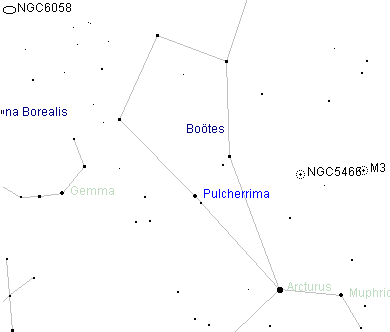Anything but Galaxies
Jack Kramer
Here's a challenge: Go out to a dark sky site and don't observe any galaxies. Sound easy? Guess again! There is something about galaxies that always draws us in. Perhaps it's the contemplation that we are looking at other island universes many millions of light years away. Surely, one factor has to be that there are so many of them. At any time of the year in almost any area of the sky, if you know where to point your telescope, you'll see galaxies. Lots of them. So some night, why not plan to only find other kinds of objects? Here are a few candidates, a couple of which will test your observing skills. The following objects can all be found on Chart 7 of the Tirion Sky Atlas 2000.
NGC 6058 is a small, faint planetary nebula in Hercules that is somewhat easier to snag if you use an Oxygen III filter; it appears as an out-of-focus star. It can be easily overlooked, but the Uranometria helps confirm its location.
NGC 5466 is a 9.1 magnitude globular cluster in Bootes that I passed over many times before realizing it was there. Being that bright, you'd expect that it's easy to see. Not so! Because it's a relatively large globular, the light is spread over a large area. The brightest stars in this cluster are 11th magnitude. As a result, it appears as a faint, shapeless glow. Once you're in the right area, jiggling the scope a bit seems to help in spotting it. Then using averted vision, my 10-inch just resolved this formless glow into innumerable specks of light. You'll need a fairly dark site, since there's no such thing as a "globular cluster filter". I snagged it from our site at the Von Bergen farm in Hebron.
Also in Bootes is the beautiful double star 36 Bootis (Epsilon). F.G.W. Struve named it "Pulcherrima" due to its nice color contrast. In my 10-inch reflector, it appears as a bright yellow star with a little bluish star just stuck on the edge of it. My 4-inch refractor splits it cleanly into separate dots.
As long as we're in the area, swing just a bit west to the very rich globular cluster M3, which is just over the border in Canes Venatici. At magnitude 6, it's a lot easier to observe than NGC 5466. In a dark enough sky you should be able to see it in an 8x50 finder. It's just resolved in a 4-inch refractor, and larger instruments show it as really spectacular. The outer stars seem to radiate from the core into fairly distinct streams. Even backyard observers should have no problem observing this cluster.
Despite concerted efforts, I've never succeeded in completely avoiding galaxies. I may have set out to find non-galaxies, but invariably the universe is too overwhelming. As if directed by an unseen hand, the scope always finds a galaxy. Especially into Canes Venatici, we get perilously close to the magnificent Whirlpool galaxy... Hey, I offered you the challenge to avoid galaxies -- I didn't say I met the challenge!
Published in the May 1998 issue of the NightTimes





